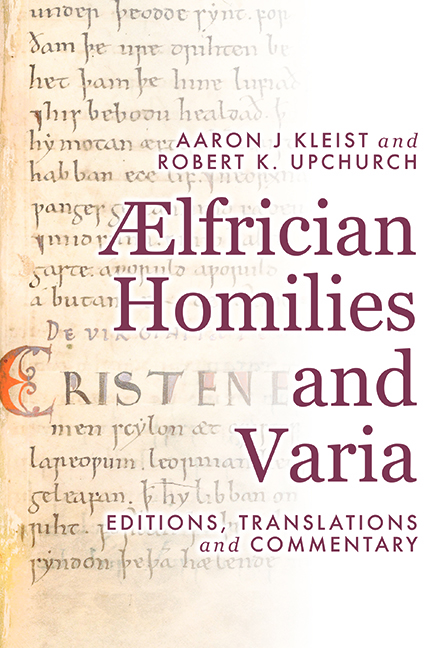Book contents
- Frontmatter
- Contents
- Preface
- Acknowledgements
- Abbreviations
- Sigla for Cited Ælfrician Manuscripts
- Dates for Cited Ælfrician Works
- Editorial Conventions
- Conventions Used in the Commentaries
- Homilies The Proper of the Season
- Homilies The Proper of the Saints
- Ælfrician Homilies and Varia: Editions, Translations, and Commentary: Volume II
- Homilies The Common of the Saints
- Homilies Unspecified Occasions
- Varia
- Works Cited
- Index
- ANGLO-SAXON TEXTS
9 - A Confessor: Sermo in natale unius confessoris (‘A Sermon for the Feast-day of a Confessor’)
Published online by Cambridge University Press: 05 March 2024
- Frontmatter
- Contents
- Preface
- Acknowledgements
- Abbreviations
- Sigla for Cited Ælfrician Manuscripts
- Dates for Cited Ælfrician Works
- Editorial Conventions
- Conventions Used in the Commentaries
- Homilies The Proper of the Season
- Homilies The Proper of the Saints
- Ælfrician Homilies and Varia: Editions, Translations, and Commentary: Volume II
- Homilies The Common of the Saints
- Homilies Unspecified Occasions
- Varia
- Works Cited
- Index
- ANGLO-SAXON TEXTS
Summary
The Sermo in natale unius confessoris (‘Sermon for the Feast-day of a Confessor’) is Ælfric's second homily for this liturgical occasion, his first being that in the Second Series of Catholic Homilies (CH II.38). In the Second Series, the confessor homily formed one of six sermons for the Common of the Saints, that is, sermons for various categories of saints (apostles, martyrs, confessors, virgins, and patron saints of churches) to be used to commemorate individuals without a designated mass of their own. Ælfric's confessor homilies honor a man of religious vocation who confessed his faith by preserving his chastity, persisting in prayer, and faithfully preaching God's word, and they were to be read on his natalis (‘nativity’ or ‘birthday’), the day he was born into eternal life. Both texts are pericope homilies intended for the laity. In CH II.38, Ælfric expounds the Parable of the Talents in Matthew 25.14–30 and applies it to the clergy and the laity ‘so that the teacher-saint or holy confessor comes to stand as a model of the Christian who puts God's talents to work’. In the Sermo, he likewise celebrates the teacher-saint, but not in such a way as to collapse distinctions between the layperson and cleric. Rather, his interpretation of Christ's exhortation to his disciples to keep watch for the Second Coming in Matthew 24.42–7 draws attention to the authority and responsibility of preachers to reprove and restrain foolish laymen.
Ælfric freely composes his exegesis with occasional recourse to Bede's Commentary on the Gospel of Luke (In Lucae Euangelium expositio), where an analogous account of the Parable of the Talents is found (Luke 12.35–48), and perhaps homilies by Pope Gregory and Haymo of Auxerre. As he works his way through successive verses in the first part of the homily [lines 5–171], his application of the passage to all believers – who must keep watch against the devil [lines 50–93], prepare for an inevitable death with good deeds [lines 94–113], and be vigilant to avoid an evil demise [lines 114–27] – narrows. He comes to focus on the teacher-saint, not as a model Christian but as a model preacher.
- Type
- Chapter
- Information
- Ælfrician Homilies and VariaEditions, Translations, and Commentary, pp. 489 - 530Publisher: Boydell & BrewerPrint publication year: 2022

